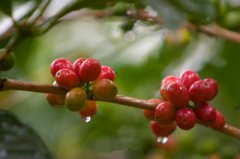Brazilian boutique coffee beans common sense coffee bean output
Global coffee production depends on whether Brazil's production cycle is even or odd, but Brazil's production first depends on Minas, which has a bumper harvest or a poor harvest, only Serrado and South Minas in the Midwest.
Minas province is bordered by Sao Paulo to the south, Bahia to the north and Esp í rito Santo to the east. It is located at 15 to 20 degrees south latitude and will not frost in winter. It is gratifying to note that the rise of South Minas and Serrado has helped Brazilian coffee, which is heavy but not quality, to be of both quality and quality, and even become a new field of boutique coffee in the world. If Minas province is the main producing area of Brazilian coffee, then South Minas and Serrado are Brazilian boutique coffee areas.
Minas Province has become an important coffee producing area in the world, that is, in the last two or three decades, the process is quite legendary. Before ○ 1997, the main coffee producing areas in Brazil were located in the southern provinces of Parana and Sao Paulo. In the past, Minas province was considered unsuitable for the development of coffee cultivation, because the climate was too dry, coffee would be "dehydrated" and died. But more than half of Parana and S ã o Paulo are located at more than 23 degrees south latitude. It often frosts in winter and coffee trees often freeze to death. In the 1970s, coffee growers began to try to move their planting areas to the warmer, frost-free province of Minas to the north, but the land was barren and the grasslands were endless, so farmers had to treat them like dead horses. Unexpectedly, these unfavored coffee crops survived. Later, scholars found that Minas' winter was extremely dry, but Rain Water was abundant in summer and had a clear-cut stand in the dry and wet season, which most helped to improve the quantity and quality of coffee fruit. the only disadvantage was that the land contained too much iron and lacked essential minerals such as nitrogen and calcium. To this end, the Brazilian authorities do not hesitate to spend a lot of money to "tailor" the soil minerals to different varieties of high technology, help coffee grow healthily, and build an irrigation system on a large scale to overcome the congenital adverse conditions of Minas drying. After 1980 ○, farmers from S ã o Paulo and Parana provinces launched a "Northern Expedition" of coffee and poured into Minas to reclaim coffee fields, which made today's glory. All this is thanks to the cultivation of science and technology, which adds an example to the triumph of man over nature.

Important Notice :
前街咖啡 FrontStreet Coffee has moved to new addredd:
FrontStreet Coffee Address: 315,Donghua East Road,GuangZhou
Tel:020 38364473
- Prev

The only coffee type in the United States, Hawaiian Kona Coffee with a long history.
Kona Coffee has a long history. In 1828, the missionary Lagers first introduced the bourbon species from Brazil, but in 1892 he introduced Tibica from Guatemala. Farmers found that iron is more adaptable to water and soil than cards, so they completely replanted Guatemalan Tibica, becoming today's famous variety Kona Typica. The Kona coffee on the big island is planted at an altitude of about 300 to 1.
- Next

Brazilian boutique beans main stem South Minas coffee beans
Brazil is flat, with coffee farms mostly about 600-1000 meters above sea level, suitable for growing shade-free Kaddura, New World and Kaduai, also known as Sm CofFee. This is the main reason for the lack of aroma of Brazilian coffee (but when the altitude is more than 1100 meters, the taste of exposed coffee will improve, comparable to bourbon. See Chapter 4 of this book). The good news is that
Related
- Detailed explanation of Jadeite planting Land in Panamanian Jadeite Manor introduction to the grading system of Jadeite competitive bidding, Red bid, Green bid and Rose Summer
- Story of Coffee planting in Brenka region of Costa Rica Stonehenge Manor anaerobic heavy honey treatment of flavor mouth
- What's on the barrel of Blue Mountain Coffee beans?
- Can American coffee also pull flowers? How to use hot American style to pull out a good-looking pattern?
- Can you make a cold extract with coffee beans? What is the right proportion for cold-extracted coffee formula?
- Indonesian PWN Gold Mandrine Coffee Origin Features Flavor How to Chong? Mandolin coffee is American.
- A brief introduction to the flavor characteristics of Brazilian yellow bourbon coffee beans
- What is the effect of different water quality on the flavor of cold-extracted coffee? What kind of water is best for brewing coffee?
- Why do you think of Rose Summer whenever you mention Panamanian coffee?
- Introduction to the characteristics of authentic blue mountain coffee bean producing areas? What is the CIB Coffee Authority in Jamaica?

